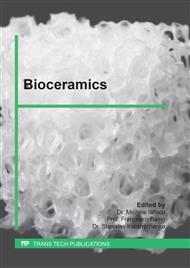p.59
p.65
p.71
p.77
p.83
p.91
p.97
p.105
p.113
A Comparative Study of Granular Agglomeration between 3D Printed Hydroxyapatite and Commercial Bone Graft Granules
Abstract:
Granule characteristics and the agglomeration ability of 3D printed hydroxyapatite granules (3DP HA) when contacting water were compared to those of commercial bone graft granules based on hydroxyapatite/β-tricalcium phosphate/collagen mixture (Sunmax). Microstructure, phase composition, water absorption and granular agglomeration of the granules were characterized. SEM showed that the granule sizes of Sunmax were in the range of 0.8-1.5 mm whereas that of 3DP HA was relatively more uniform at about 1 mm. 3DP HA granules comprised the weaving of numerous minute crystals containing large pores and having high porosity while Sunmax granules were crushed granules and having low porosity. XRD analysis confirmed that Sunmax granules were biphasic hydroxyapatite and β-tricalcium phosphate while 3DP HA granules were monophasic hydroxyapatite. Sunmax granules exhibited greater agglomeration volume than that of 3DP HA granules. However, the water absorption of 3DP HA granules was greater than that of Sunmax granules. The greater agglomeration ability of Sunmax granules was likely due to the collagen constituent of the granules which could act as adhesive to bind granules together in addition to water capillary action. In contrast, 3DP HA granules formed the agglomeration by the water film due to the capillary action only so the efficiency was lower although the water absorption was greater.
Info:
Periodical:
Pages:
83-87
Citation:
Online since:
April 2019
Keywords:
Price:
Сopyright:
© 2019 Trans Tech Publications Ltd. All Rights Reserved
Share:
Citation:



